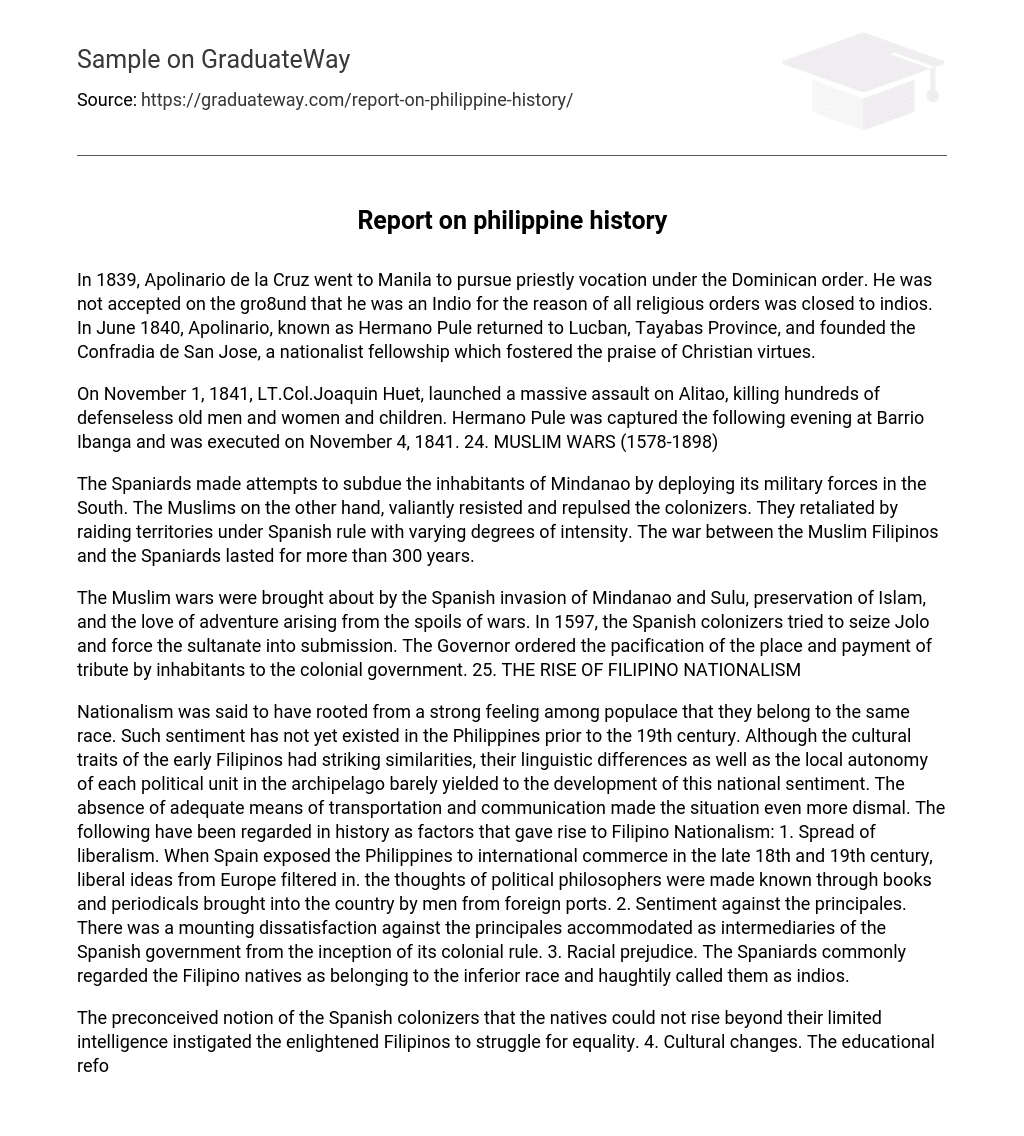In 1839, Apolinario de la Cruz sought to become a priest with the Dominican order in Manila. However, due to his status as an Indio, he was denied entrance since religious orders were not open to indios. Apolinario, also known as Hermano Pule, returned to Lucban, Tayabas Province in June 1840 and established the Confradia de San Jose. This nationalist association aimed to promote the admiration of Christian virtues.
On November 1, 1841, an extensive attack was carried out by LT.Col.Joaquin Huet against Alitao. During the assault, hundreds of defenseless elderly individuals, women, children lost their lives. Hermano Pule was apprehended the next day at Barrio Ibanga and was later executed on November 4, 1841. These events took place in the context of the Muslim Wars (1578-1898).
The Spaniards attempted to conquer the people of Mindanao by sending their military to the South. However, the Muslims bravely fought back and successfully drove away the colonizers. As a form of retaliation, they launched raids on territories that were under Spanish control, with different levels of intensity. This conflict between the Muslim Filipinos and the Spaniards continued for over three centuries.
The wars waged by the Muslims were a result of the Spanish invasion of Mindanao and Sulu, the desire to preserve Islam, and the thirst for adventure fueled by the spoils of war. In 1597, the Spanish invaders attempted to conquer Jolo and impose submission on the sultanate. The Governor then commanded the pacification of the area and imposed tribute payment by the residents to the colonial government. 25. The emergence of Filipino nationalism.
Before the 19th century, the Philippines did not have a strong sense of nationalism. Although the early Filipinos had cultural similarities, their linguistic differences and the autonomy of each political unit hindered the development of a national sentiment. The lack of transportation and communication further exacerbated this situation. However, there were several factors that contributed to the rise of Filipino Nationalism:
- The spread of liberalism: In the late 18th and 19th century, Spain introduced the Philippines to international commerce, which brought in liberal ideas from Europe. Political philosophers’ thoughts were disseminated through books and periodicals brought to the country by individuals from foreign ports.
- Sentiment against the principales: The intermediaries of the Spanish government, known as principales, faced increasing dissatisfaction from the Filipino populace since the start of colonial rule.
- Racial prejudice: The Spaniards viewed the Filipino natives as inferior and derogatorily referred to them as indios.
The Spanish colonizers held the belief that the natives lacked intelligence, leading the enlightened Filipinos to fight for equality. The reforms of 1863 brought significant improvements to primary level education and allowed qualified Filipinos to pursue higher education. The secularization controversy arose when the council of Trent mandated the appointment of secular priests to administer parishes in the colony. Due to a shortage of secular priests, King Philip II requested Pope Pius V to issue the Exponi Nobis in 1567, permitting regular clergy to serve as parish priests without diocesan authorization and be exempt from bishops’ authority. The Cavite mutiny of 1872 occurred after a revolution in Spain led by liberals deposed Queen Isabella II and established the provisional republic of Spain. This led to the arrival of colonial officials with democratic ideals, including Governor General Carlos Maria de la Torre in 1869.
La Solidaridad (solidarity) is a solely Filipino organization that was established in Barcelona on December 31, 1888. Galiciano Apacible served as the president and Graciano Lopez Jaena as the vice-president. To communicate the objectives of their propaganda, Lopez Jaena started a fortnightly newspaper called la solidaridad. The newspaper was first published in Barcelona from February 15- October 31, 1889 and later in Madrid from November 15,1889 until its final issue on November 15, 1895. Additionally, it is worth mentioning that it was during this period that the Katipunan was also recognized.
Some members of la liga Filipina realized that advocating for reforms peacefully was insufficient, and they prioritized the Philippines’ liberation above everything. Among these individuals was Andres Bonifacio, who committed to back the propaganda movement in Spain.
On the night of July 7, 1892, Bonifacio and his friends gathered discreetly at deodato arellano’s house. They resolved to establish a clandestine revolutionary organization, partially inspired by the Masonic order known as kataastaasang kagalang-galangang katipunan ng mga anak ng bayan, or K.K.K. This group, also referred to as katipunan, aimed to achieve national independence through armed revolution.





